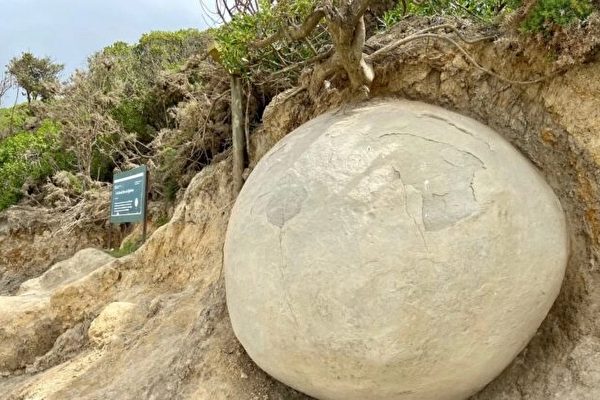Off the coast of Oamaru town in the South Island of New Zealand, approximately 40 kilometers away, lies a beach adorned with unusually large, nearly perfect spherical boulders, creating a strange geological phenomenon. Known as the Moeraki Boulders, or “Kaihinaki” in Maori, they are situated on Koekohe Beach. Their unique shapes and diameters reaching up to 2.2 meters have captured the excitement of both visitors and scientists.
Since the Victorian era, numerous theories have been proposed regarding the origin of these boulders. In Maori language, “Moeraki” means “a place to sleep during the day,” a name derived from a legend of the ancient navigator Kupe who reportedly took a rest on Moeraki Beach while exploring the South Island.
According to Maori folklore, the origin of the spherical boulders is attributed to the wreckage of a large canoe called Araiteuru carrying ancestors of the Ngai Tahu tribe, indigenous to the South Island. The legend suggests that these boulders are remnants of gourds and kumaras (sweet potatoes) from the sunken canoe, gradually turning into stone over time as they washed ashore.
In a comical twist possibly inspired by the 1985 film “Cocoon,” another humorous explanation suggests that the boulders are eggs hatching aliens.
Modern science paints a slightly different story of the boulders’ origin, describing them as concretions formed when mineral cement fills the spaces between sediment grains and hardens over time. Comprising mud, silt, and clay, these boulders, with the largest estimated to weigh several tons, feature hollow cores with fissures radiating outward known as “septaria.”
A central theory posits that these boulders originated on the seabed millions of years ago. According to this hypothesis, mineral-rich mud slurry and silt accumulated around a central core, such as a fossil or shell, gradually hardening into a spherical shape. Erosion of surrounding rock layers over time exposed these concretions, eventually revealing them on the beach.
Another theory suggests that these boulders formed around 60 million years ago during the Paleocene epoch. During that period, these boulders might have been formed within ancient sea cliffs and later exposed due to coastal erosion. This theory is supported by the presence of similar concrete-like formations in nearby cliffs dating back to the same period.
Regardless of their origins, the Moeraki Boulders stand as a marvel to behold, especially during sunrise or sunset when they cast long shadows on the beach. They have become a popular tourist attraction, with visitors from around the world amazed by their size and shape. The surrounding area offers plenty of opportunities for exploration, with visitors able to admire the stunning coastal scenery along the beach and nearby cliffs.
Despite their popularity, the Moeraki Boulders are fragile and legally protected to prevent damage or removal. Authorities encourage visitors to admire them from a distance and respect the natural environment where they are located.
The unique spherical formations are not exclusive to the South Pacific. In the United States, Bowling Ball Beach in Mendocino County, California, features spherical sandstone boulders that appear during low tide at Schooner Gulch State Beach. Costa Rica also boasts a collection of about 300 perfectly round stone spheres scattered across the Diquís Delta and Isla del Caño.
In the northern regions, the Koutu Boulders present another intriguing geological feature. Located on Koutu Beach in Hokianga Harbour, North Island of New Zealand, these boulders resemble the Moeraki Boulders in appearance. Their size, shape, and mysterious origins captivate visitors similarly.
The Koutu Boulders, usually smaller than their southern counterparts, range in diameter from about 0.5 meters to 1 meter, though some larger ones exist. Like the southern boulders, the Koutu Boulders are formed from sedimentary rock, with layers of mudstone and sandstone binding together over millions of years to form spherical shapes. Partially buried in sand, only parts of them are visible, lending them a unique and intriguing appearance.
One of the most fascinating aspects of the Koutu Boulders is their location in Hokianga Harbour, a place of significant cultural importance to the Maori in New Zealand. The connection between Hokianga Harbour and Moeraki Beach, where the navigator Kupe rested, weaves a rich tapestry of legends.
According to tradition, the harbor served as his departure point for returning to his homeland in Hawaii. As per the Maori history website Te Ara, Kupe left behind two taniwha (water spirits) to guide subsequent Polynesian arrivals safely ashore.
Regardless of which origin story one believes, the unique appearance of these boulders and the mysterious background stories passed down by oral historians continue to attract numerous visitors, adding to the wealth of natural wonders found throughout the “Land of the Long White Cloud.”

